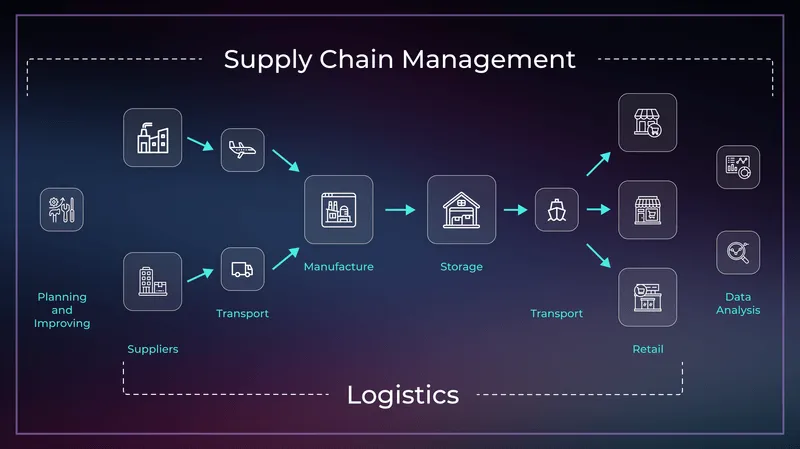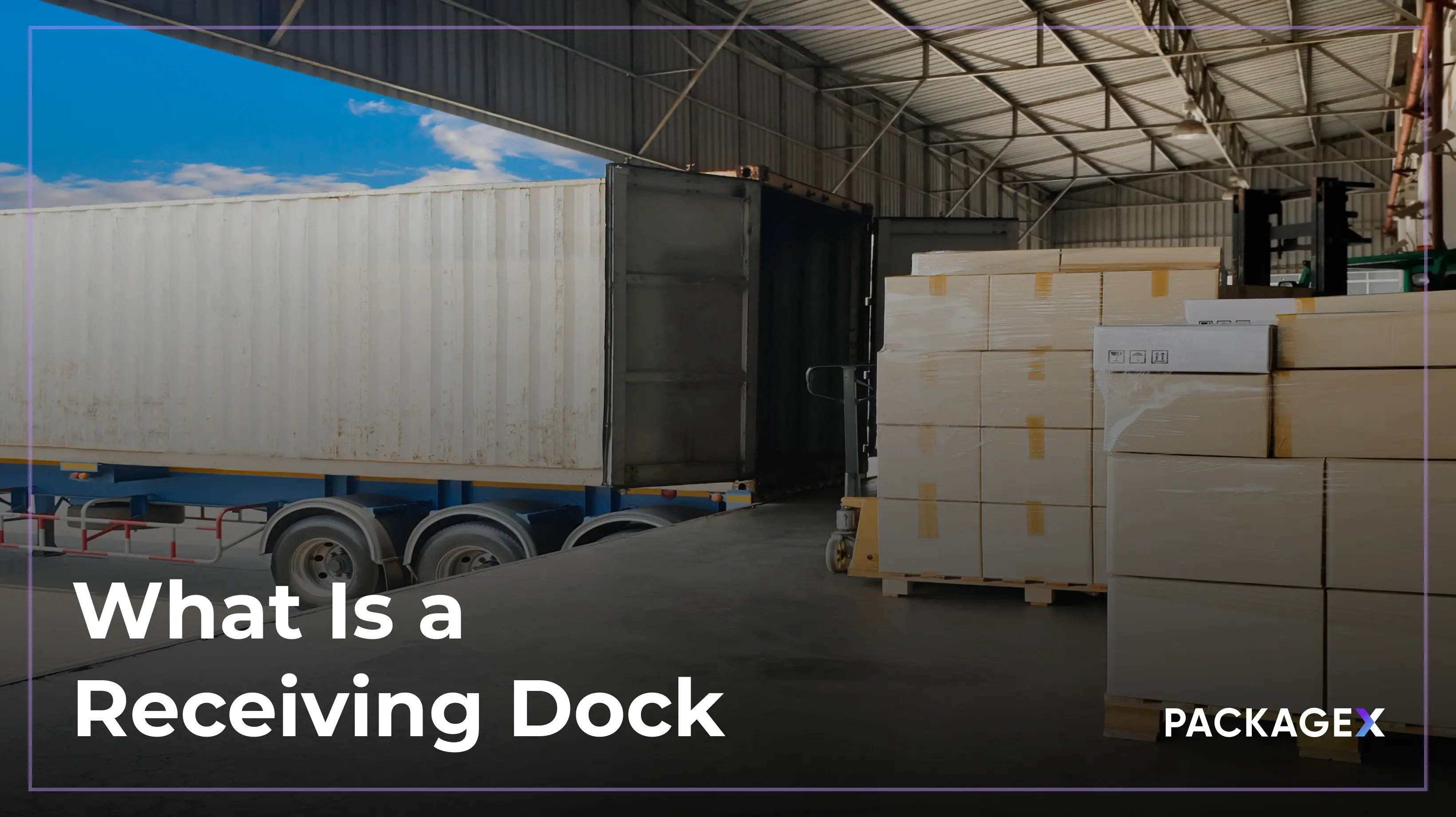Understanding the nuances between logistics and supply chain management can significantly impact your operational efficiency, customer satisfaction, and competitiveness.
Supply chain management is an all-inclusive term that includes multiple processes aimed at achieving a competitive advantage. It coordinates and integrates various activities, from sourcing to delivery, to create a seamless and efficient flow of goods. Logistics, on the other hand, focuses on the movement, storage, and flow of goods within the supply chain. It's a critical component of supply chain management, dealing with the tactical aspects of getting products from one place to another.
What is Supply Chain Management (SCM)?
Supply chain management is more than just getting products from point A to point B. It's about strengthening collaborations between suppliers, customers, and partners to create a seamless flow of goods and services that ultimately delights the end consumer. You need to focus on strategic decisions to set up an operational framework that streamlines logistics and boosts efficiency.
At its core, supply chain management is about coordinating every step of a business's production process, from sourcing raw materials to delivering the final product. Synchronizing these moving parts can help your business create value and reduce costs to stay ahead of the competition.
Want to learn more about the art of supply chain management? Our in-depth article offers expert insights and real-world examples to help you understand how logistics and supply chain management differ.
What are Logistics?
Logistics involves planning, implementing, and controlling the flow of goods, services, and related information from the point of origin to the point of consumption. In the high-stakes world of supply chain management, logistics plays an important supporting role. A well-functioning logistics flow ensures that goods and services reach customers on time, in the right place, and in top condition. Logistics and supply chain management work in tandem to make this happen. It's a tall order that requires precision, coordination, and the ability to adapt to changing customer needs. But what exactly does logistics entail, and how can businesses optimize this process?
Transportation, warehousing, packaging, and other logistics subtasks may seem disparate, but they're all crucial to synchronizing the supply chain and delivering products efficiently. To achieve this, businesses must master two key subcategories: inbound logistics and outbound logistics. Inbound logistics focuses on obtaining materials, handling storage, and transportation, while outbound logistics concerns itself with collecting, maintaining, and distributing products to customers. By understanding the intricacies of logistics and supply chain management, businesses can identify areas for improvement, reduce costs, and ultimately boost customer satisfaction.
Understanding the role of logistics in supply chain management
Logistics is a significant part of supply chain management, as it focuses on the movement, storage, and tracking of goods and services throughout their journey to the customer. It involves coordinating transportation, warehousing, and documentation to ensure timely delivery of products.
This is why logistics training is crucial for keeping companies up-to-date with evolving industry trends and improving overall supply chain performance.
Logistics vs Supply Chain Management
Now, you recognize that logistics and supply chain management shouldn't be used interchangeably; they complement each other. One process relies on the other to function. Here are the differences to help distinguish between them:
Importance of Logistics and Supply Chain Management for Business Success
Supply chain management (SCM) and logistics both meet customer needs and enhance the buying experience. Logistics provides direct feedback on demand, which SCM uses to plan production and inventory levels. A strong logistics system ensures cost-effective, reliable delivery, laying the foundation for efficient SCM. In turn, SCM manages the entire supply flow, ensuring that orders are filled accurately and on time, which helps businesses attract new customers and grow profits.
PackageX offers logistics and inventory management solutions that can help you manage your SCM system. Inventory management tools track stock levels, including reserved and en-route items. If you have multiple warehouses or retail sites, our multi-location management tool can support your business. Seamless order fulfillment covers picking, packing, and shipping to consumers, and our mobile apps streamline receiving and scanning processes.
IKEA’s logistics and supply chain management
IKEA, a global leader in home furnishings, has long been recognized for its forward-thinking approach to managing its vast and complex supply chain. One of IKEA's best innovations in logistics and supply chain management is its methodical approach to inventory management. To reduce waste and avoid inefficiencies caused by excess stock, IKEA introduced "minimum" and "maximum" settings for their products. This system ensures that the company only reorders products when inventory drops to a certain level (minimum) while also capping the number of items that can be stocked at once (maximum). This prevents over-ordering and optimizes warehouse space, ensuring faster-moving products are prioritized.
This supply chain strategy relies on automation and inventory optimization to enhance efficiency and sustainability. Adopting suitable inventory management systems can help your business manage complex processes and cut costs. This clearly shows that logistics management is crucial in addressing supply chain challenges and positioning the company competitively against its major rivals. Wondering how you can optimize these processes with artificial intelligence? Read this very informative piece about utilizing AI in logistics and supply chain management.
{{returns-webinar}}
Best Practices in Logistics and Supply Chain Management
- Establish good communication with suppliers: Build strong, mutually beneficial partnerships with suppliers to create reliability.
- Purchase supplies in volume to reduce costs: Apply economies of scale through bulk purchasing for cost savings.
- Improve demand forecasting: Enhance accuracy in predicting demand to avoid overstock or stockouts.
- Optimize inventory management: Implement efficient inventory strategies based on accurate demand forecasting.
- Track supply chain metrics: Use key performance indicators (KPIs) to measure and optimize supply chain performance.
- Increase supply chain visibility: Ensure end-to-end transparency across the entire supply chain to reduce errors.
- Centralize document management: Use a unified platform for managing supply chain documents to improve clarity and reduce mistakes.
- Improve order-to-pay process: Automate and streamline the order-to-pay cycle for better visibility and efficiency of your logistics and supply chain management
- Practice risk mitigation: Proactively identify and mitigate risks to safeguard supply chain operations.
- Focus on Total Cost of Ownership (TCO): Consider the full costs of the supply chain to make informed decisions.
- Invest in technology: Implement integrated technology solutions to drive real-time decision-making and operational efficiency.
Ready to Optimize Your Supply Chain and Logistics Management?
Logistics and supply chain management are distinct but interdependent. Logistics focuses on the movement and storage of goods, while SCM oversees the entire flow from sourcing to delivery. Effective logistics boosts supply chain efficiency, ensuring timely deliveries and customer satisfaction. You can improve your business operations by leveraging automation, AI, and inventory management systems to streamline processes and cut costs.
Looking to optimize your supply chain with AI-powered solutions? Begin by exploring PackageX's tools, which are designed to keep your supply chain running at peak efficiency. PackageX Cloud offers cutting-edge solutions to streamline every stage of the process. Its advanced inventory management tools track stock levels in real time, including items reserved for fulfillment or en route to customers. Let us help you simplify picking, packing, and shipping to ensure timely deliveries. You can use your own mobile phone for instant AI scanning and faster verification. For businesses with multiple warehouses or retail sites, the multi-location management feature allows seamless coordination across all locations, giving you full control of your supply chain.
Frequently Asked Questions
What does a logistics and supply chain manager do?
Supply chain managers goods move seamlessly from suppliers to customers. They focus on optimizing transportation routes, selecting the right logistics partners, and managing warehousing and distribution centers. By tracking shipments closely, they ensure timely deliveries while keeping costs in check. Their ultimate goal is to streamline the entire process and achieve efficiency, customer satisfaction, and cost-effectiveness.
Is logistics part of the supply chain?
Logistics connects the dots between manufacturers, suppliers, and customers. It's the delicate process of planning, coordinating, and executing the efficient flow of goods, services, and information from the point of origin to the point of delivery. Careful execution helps meet customer needs with precision and timeliness.
Is supply chain and logistics the same?
The best way to understand logistics and supply chain management is to see logistics as a subset of supply chain management. While supply chain management controls the activities between separate entities, logistics takes center stage when it comes to the internal movement of goods within an organization. Simply put, supply chain managfement includes the entire lifecycle of a product, from procurement to production and, ultimately, delivery to the end customer. Logistics, on the other hand, is focused on the efficient movement and storage of goods between different points within the supply chain.




